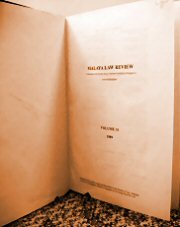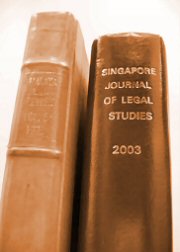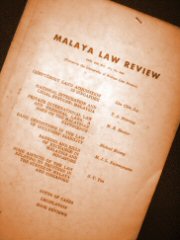|
Archive |
2386 records match your query:
| 81. | MARCH 2021 Issue | p.267 | |
| | Book Review: Asian Principles for the Recognition and Enforcement of Foreign Judgments by Adeline Chong
Béligh Elbalti • [2021] Sing JLS 267 (Mar)On 3 September 2020, the Asian Principles for the Recognition and Enforcement of Foreign Judgments (hereinafter, "Asian Principles" ) adopted under the auspices of the Asian Business Law Institute was officially released, a date that may be considered a turning point in the history of legal developments in the field of recognition and enforcement of foreign judgments in Asia. This is because to date, there is no single regional framework that ensures the smooth circulation of judgments between neighbouring states despite strong economic ties that bind the various Asian jurisdictions. Many of these states (such as Indonesia, Japan, the Philippines, South Korea, Thailand etc .) have not even showed eagerness to establish their own networks of bilateral cooperation to that effect (for an earlier unfruitful attempt, see Asian-African Legal Consultative Committee, Report of the Seventh Session Baghdad 1965 (1966)). This status quo might intrigue outsiders' curiosity. Indeed, unlike Europe, Latin America, or intergovernmental organisations such as the Commonwealth of Independent States ("CIS"), the League of Arab States ("LAS") or the Gulf Cooperation Council ("GCC"), where regional schemes on judgments recognition and enforcement have already been in place, the lack of interest displayed in some parts of Asia, at least at an official or diplomatic level, is hardly comprehensible. This is more so knowing that the field of international arbitration has a completely different picture although the need to foster economic growth and to guarantee legal certainty and predictability is indifferent to which method of dispute resolution is adopted.
| | 82. | SEPTEMBER 2020 Issue | p.363 | |
| | Introduction: Contemporary Issues in Public Law—Theory, Doctrine and Practice
Swati Jhaveri • [2020] Sing JLS 363 (Sep)This is the second part of the special symposium section of the Singapore Journal of Legal Studies; the first was published in September 2019. The two symposia issues bring together a collection of papers that look at contemporary issues relating to public law and litigation in Singapore. Despite the flourishing of research in the area in the recent decade, there are a number of areas of public law that remain under-explored. As highlighted in the Introduction to the September 2019 symposium section, not only has there been an increase in the number of applications for judicial review, there has also been an increasing diversity in the issues mooted in courts in recent years. Since the last symposium issue was published, applicants have continued to bring important public law issues to court. The courts have had to consider the effect of ouster clauses in legislation, whether and when courts can adopt a rectifying construction of legislation, the constitutionality of holding general elections in 2020 during the coronavirus pandemic implicating once more the 'right to vote' in the courts, the constitutionality of the mode of carrying out the death penalty, challenges of correction directions issued pursuant to the new Protection from Online Falsehoods and Manipulation Act 2019 and further challenges to section 377A of the Penal Code. The courts have also recently looked at applying a proportionality-style of analysis to the review of the constitutionality of legislation.
| | 83. | SEPTEMBER 2020 Issue | p.367 | |
| | A Place to Stand to Move the Earth: Standing and the Rule of Law
Jack Tsen-Ta Lee • [2020] Sing JLS 367 (Sep)It has been said that rules relating to standing ( locus standi ) in public law try to resolve the conflict between the "desirability of encouraging people to participate actively in the enforcement of the law" and the "undesirability of encouraging meddlesome interlopers invoking the jurisdiction of the courts in matters in which they are not concerned". Nonetheless, standing rules that are excessively restrictive may result in certain forms of governmental action being virtually immune from judicial scrutiny. This article argues that recasting the standing rules to focus on an applicant's suitability to bring a claim and whether the claim is sustainable on its merits accords better with the courts' role as a check on the political branches of government and their duty to uphold the rule of law.
| | 84. | SEPTEMBER 2020 Issue | p.392 | |
| | Ousting Ouster Clauses: The Ins and Outs of the Principles Regulating the Scope of Judicial Review in Singapore
Thio Li-ann • [2020] Sing JLS 392 (Sep)How a court responds to an ouster clause or other attempts to curb its jurisdiction, which seeks to exclude or limit judicial review over a public law dispute, is a reflection of the judicial perception of its role within a specific constitutional order. Article 4 of the Singapore Constitution declares the supremacy of constitutional law over all other forms of law—whether statutory, common law or customary in origin. The courts have judicially declared various unwritten constitutional principles which are of particular relevance to the question of the scope of judicial review, particularly, the separation of powers and the rule of law.With comparative references where illuminating, this article examines the scope of judicial review in Singapore administrative law, in the face of legislative intent that it be partially truncated or wholly excluded, with a view to identifying and evaluating the factors that have been judicially considered relevant in ascertaining the legitimacy of an ouster clause, including the Article 93 judicial power clauses and the inter-play of other constitutional principles.
[Full Text]
| | 85. | SEPTEMBER 2020 Issue | p.427 | |
| | The Application of Administrative Law Principles in Private Law: The Case for Convergence
Calvin Liang • [2020] Sing JLS 427 (Sep)The common law represents an ongoing negotiation between past precedents and present-day principles and policies. If, as will be argued, the basis of the common law and judicial review in particular is the courts' duty to protect the individual from the effects of dominant power, then we must look to where that dominant power will increasingly reside. In the past, that power resided predominantly with the state. The future promises to be one with metanational private organisations disrupting that monopoly of power through their contractual relationships with us. Not if but when that situation materialises, the public-private function distinction that presently delineates the application of judicial review principles will increasingly sound quaint. We should therefore turn our attention to examining how judicial review principles—developed over centuries to control dominant statebased power—can be adapted to regulate the contractual relationships between powerful private organisations and us. This has possible wide-ranging implications, including a growing irrelevance of judicial review procedure, and contract law doctrines exerting at least an anchoring effect on how judicial review principles evolve.
| | 86. | SEPTEMBER 2020 Issue | p.448 | |
| | Commercial Judicial Review in Singapore: Strategic or Spontaneous?
Eugene K B Tan • [2020] Sing JLS 448 (Sep)This article examines the increasing use of judicial review under administrative law by corporate entities in Singapore to protect or even to assert strategic business interests. When used effectively, commercial judicial review can be a powerful tool. It considers why such a trend has arisen and the implications for public law litigation. The backdrop of the Attorney-General (Additional Functions) Act is also considered. The article argues that judicial review is increasingly an important consideration for companies seeking to protect their interests against what they regard as unfair or unlawful government or regulatory actions. It suggests that private sector entities in embracing public law litigation would also do well to also support administrative law values such as legality, fairness, and accountability.
| | 87. | SEPTEMBER 2020 Issue | p.479 | |
| | Fraudulent Sex Criminalisation in Singapore: Haphazard Evolution and Accidental Success
Jianlin Chen • [2020] Sing JLS 479 (Sep)In this article, I critically examine the evolution of fraudulent sex criminalisation in Singapore and make two contributions. First, I demonstrate that the major amendments to the relevant Penal Code provisions ( ie , in 2007 and 2019) were made pursuant to an attempted importation of English legal provisions, without due regard to the synergetic relationship between the imported provisions and the existing provisions in both the Penal Code and the English statutes. Second, I normatively assess the 2019 reform. I argue that the 2019 reform is desirable for two reasons: (1) the reform finally brings the plain-wording of the statutory provisions in line with what the government is prepared to fully enforce; and (2) the ostensible decriminalisation of fraudulent sex is mitigated by the broadlyworded cheating offences and the undisturbed broad judicial interpretation of how "fear of injury" may vitiate sexual consent.
| | 88. | SEPTEMBER 2020 Issue | p.502 | |
| | Rethinking Bankruptcy Alternatives in Singapore
Jodi Gardner • [2020] Sing JLS 502 (Sep)Bankruptcy processes are an integral part of any financial system; they provide an escape path for people burdened by problem debt, whilst also allowing businesses some level of clarity on the recovery of sums unpaid. Bankruptcy does however have a number of significant and longterm consequences for the debtor, and creditors are unlikely to have their accounts repaid in full. There has therefore been an increasing focus on the development of bankruptcy alternatives-allowing individuals to be released from debts without the strict processes and consequences of formal bankruptcy, whilst also maximising the returns to creditors. In Singapore, a wide variety of bankruptcy alternatives have developed, and indebted individuals can now make an educated choice based on their personal situation. This article analyses the different bankruptcy alternatives in Singapore, highlighting the benefits and detriments of the processes available and outlining some potential reforms to provide a comprehensive and accessible regime.
| | 89. | SEPTEMBER 2020 Issue | p.526 | |
| | The Failed Hopes of Disintermediation: Crypto-Custodian Insolvency, Legal Risks and How to Avoid Them
Matthias Haentjens, Tycho De Graaf and Ilya Kokorin • [2020] Sing JLS 526 (Sep)This article explores the legal risks involved in depositing cryptocurrency with crypto-custodians such as crypto-exchanges. These risks materialise most acutely in case these crypto-custodians fall insolvent, which has happened over the last decade in several instances. Recent years have witnessed the demise of crypto-exchanges such as Cryptopia (New Zealand), QuadrigaCX (Canada), BitGrail (Italy) and a host of other crypto-exchanges around the world. These cases reveal that the qualification of the contractual and property law rights of crypto-investors is problematic. This is why this article discusses which rights crypto-investors can and should be able to assert in case a crypto-custodian falls insolvent. To answer this question, the (legal) qualification of bitcoin is analysed (can it be owned and if so, how can such ownership be created and transferred?) and the status of deposited bitcoins is discussed (do stored crypto-assets form a part of the crypto-custodian's insolvency estate or can they be revendicated by customers?). Private international law aspects form the starting point of the legal analysis (which court has jurisdiction to open insolvency proceedings and hear cryptoinvestors' claims, and what law applies to such claims?) and the analysis is based on the current terms and conditions of major crypto-custodians.
| | 90. | SEPTEMBER 2020 Issue | p.564 | |
| | Charity and Law: Past, Present and Future
Matthew Harding • [2020] Sing JLS 564 (Sep)In this article, I focus on the role of law in constituting what I call 'legal charity' as a mode of social action. I begin by reflecting on how law has played a key role historically in defining a charity sector with its own distinctive character. I then turn to recent developments putting pressure on the doctrine by which law has constituted legal charity as a distinctive mode of action. Finally, I explore how law should respond to these recent developments, imagining several possible futures for the charity sector as I go, and considering whether law should continue to constitute legal charity as it has done historically, or now allow legal charity to wither and die in favour of other modes of social action.
| |
|
|


 |







